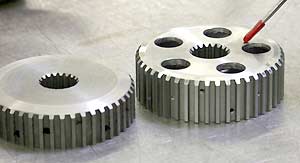| What
Makes a Race Powerglide?
By Mike
Bumbeck
10/8/04

eneral Motors introduced the aluminum Powerglide transmission in 1962. Since
fully automatic shifting was a privilege reserved
for much higher price models, the introduction
was truly a milestone moment. No engineer could
have possibly envisioned that the budget-minded
Powerglide would eventually end up behind countless
1000-plus horsepower performance engines.
The race-prepped 2-speed Powerglide is the transmission of choice for drag racing and circle track drivers alike. Running a 'Glide is as common as the small block Chevy it's often connected to, but what keeps those internal parts from tearing themselves apart? There is no single modification that allows a Powerglide to stand up to the big horsepower. A series of internal changes add up to collective strength, and make a Powerglide ready for action.
We dissembled both a stock and a race-prepared Powerglide at B&M Racing & Performance Products to demonstrate what it takes to make a Powerglide stand up to serious punishment.
 |
The input shaft is the key to strength
and durability of the racing transmission.
The 300M material is much stronger than
stock, and the shaft is splined for use
with a turbo-type converter. |
| On the left are the stock clutches. On
the right are hi-power versions. The superior
friction material handles the increased
load for added capacity. |
 |
 |
The all-steel clutch hub on the right
is much thicker than the stocker. This allows
for more clutches in the hub, which goes
inside the direct drum. Lightening holes
are also added. The stock hub is cast, and
not nearly as strong. |

|